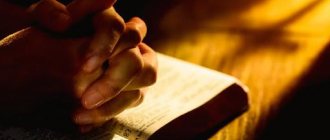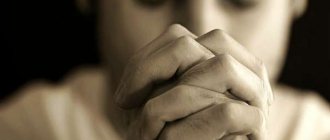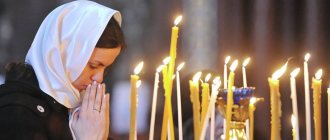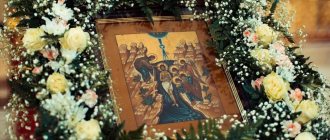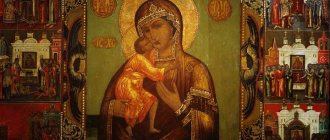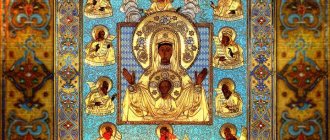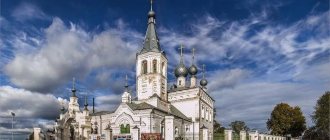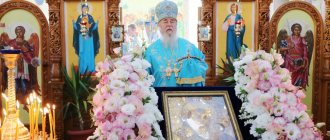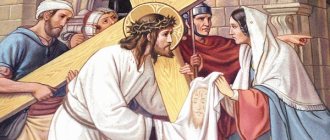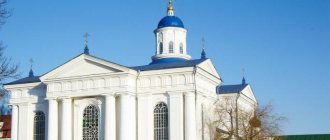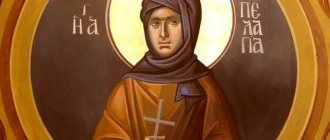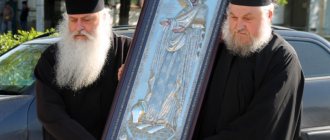Plot and meaning
The mystery of Easter is sacred and incomprehensible, therefore icon painters do not directly depict the Ascension of the Lord. Easter iconography indirectly points to the main event of the holiday with the help of previous scenes from the Gospel. One of the Easter images is the “Descent into Hell” icon. The image symbolizes the prophecy about the acquisition of immortality by righteous souls, repeatedly mentioned in the Old Testament.
The plot is based on apocryphal, patristic and liturgical works:
- "The Gospel of Nicodemus" of the 2nd century;
- “The Anchor Word”, composed by St. Epiphanius of Cyprus in the 6th century;
- sermons of Eusebius, Bishop of Alexandria, dated to the 5th-6th centuries.
The 12th century icon depicts Jesus and Adam emerging from the Underworld. Christ descends into the Darkness, holding a cross in his hand, and brings out the progenitor.
Later, the authors developed the plot. On a 15th-century Pskov icon, Christ stands at the broken gates of the underworld, with Adam to his right. Behind the back of the progenitor are depicted the figures of kings Solomon, David, other rulers and prophets mentioned in the Old Testament. On the left is Eve. The ancestress knelt before the Savior in repentance. The Old Testament wives follow her. John the Baptist is depicted at the top.
Rarely in icons of Christ's descent into hell are there three righteous wives standing around Eve. One of the righteous women stretches out her hand to the Savior. He reaches out his hand in response, calling to come out of the darkness of the underworld.
On Orthodox icons of the 16th century, angels in red robes appear, Satan defeated by them, and the righteous in white rising from their graves. Artists of the 7th century complicated the “Descent into Hell” icon with a series of marks corresponding to the main memorial days and holidays. A complex image of convergence was placed in the center.
An example of expanded iconography is the Murom Icon. In addition to the key figures of Jesus, Adam, Eve and John the Baptist, on the centerpiece there is an image of paradise, the righteous marching towards it, a prudent thief talking with the forefather Enoch and the prophet Elijah. Two angels with scrolls in their hands hover above.
Ancient icons with a complex plot and a large number of figures serve as models for painting temple images and church paintings.
Icon "The Resurrection of Christ (Descent into Hell)" – Moscow School/Dionysius
Description of the icon.
The icon of the “Resurrection of Christ” from the local row of the Nativity of the Virgin Cathedral of the Ferapontov Monastery has a size of 136.5 x 99 cm. It was painted by the famous Moscow painter Dionysius together with his sons Theodosius and Vladimir at the very beginning of the 16th century. The icon was made in full accordance with the Byzantine iconographic canon of the holiday, but has an originality that reflected the custom that developed in Russian monasteries to depict personifications of virtues and vices, denoting them with special inscriptions. A similar iconography of the “Descent into Hell” was formed under the influence of the edifying writings of Eastern ascetics, primarily St. John Climacus. Art historians suggest that the images of demons-vices, defeated by angels-virtues, were formed by the 14th century under the influence of the “Life of Vasily the New”, widespread in Rus', which describes in detail visions of Paradise, the Last Judgment and hellish torment, the struggle of angels with demons for the salvation of human souls , and human vices are contrasted with virtues. It is assumed that attention to this understanding of the event of the Descent of Christ into hell arose due to strong eschatological sentiments.
In the central part of the icon of Dionysius we see how the Savior stands on the destroyed gates of hell, around Him are figures of the righteous rising from their graves. This takes place against the backdrop of a dramatic battle between the forces of good (angels) and the forces of evil (demons), whose figures resemble dark smoky clouds. The symbolic meaning of the images of ethereal forces is explained by the corresponding inscriptions.
Light golden slides frame the presentation of the main event of the Resurrection of Christ. Above the black pit of hell, at the crossroads of the defeated gates of hell, Jesus Christ stands solemnly - the true King of Glory in the form of a man. The figure of the Savior is drawn light and weightless, this is conveyed by light clothes, permeated with a golden glow, in accordance with the words “dressed with light, like a robe.” He is depicted against the background of Glory - the blue mandorla, the light that He brought into the darkness of hell.
The Savior spread his arms wide, with one of them He led Adam out of the tomb, and with the other, Eve. Adam is followed by majestic elders - the biblical patriarchs Abraham, Isaac and Jacob. Behind them can be seen a young man in a skin - Abel, the son of Adam and Eve, as well as David, Solomon and the prophet Daniel crowned with crowns in a special headdress. Following Eve, they rise from the tombs of the foremother, stretching out their hands to Christ. Following them is John the Baptist, who points to Christ, explaining His coming. Next to him, an old man with an ark in his hands looks at the Savior - the righteous Noah, who saved every creature.
Behind these characters of Sacred History, on both sides of Christ, come those whose figures are not so well recognized. They show an endless procession of righteous people emerging from hell, led by Adam and Eve, leaving behind the mandorla. The faces of those who follow Christ are pure, their colorful clothes are permeated with light, they resist the darkness and darkness of hell. The blackness is emphasized by the whiteness of the clothes just rising from the coffins. In this darkness, an angel and an archangel stand out, shackling Satan, thereby establishing the final triumph of light.
The icon shows not only the completeness of victory, but also the path to it. Above Christ, shining in glory, two angels raise high the cross - a means of death and suffering, which was an instrument of victory over evil. The blue mandorla is filled with light, almost indistinguishable twelve angelic figures. In the small white spheres that they hold in their hands, inscriptions are visible, meaning various virtues - mercy, virginity, fasting, humility, love, peace, meekness, joy. With long spears with sharp three-pronged ends, they precisely hit the gray demons, above which the inscriptions are visible - fornication, rage, bribery, greed. Only through virtues can human vices be overcome, and in this way the fullness of the salvation given by Christ is achieved. This image of the Resurrection of Christ is directly related to the words of the psalm “Let God rise again, and let His enemies be scattered...; As the smoke disappears, let them disappear...”
This icon, which is probably one of the last works of Dionysius, is painted on a composite board and, despite its age, is in fairly good preservation. Art historians note a slight loss of gold in the background and margins, as well as wear and tear of the paint layer on the “Glory” around Christ.
The icon was kept in the Mother of God Nativity Monastery in the Vologda village of Ferapontovo until its closure in 1924. After that, it was moved to the nearby Kirillo-Belozersky Monastery, where a museum was formed. It remained in this museum until 1962, when it was taken to Leningrad for restoration in the workshops of the State Russian Museum. During the restoration, the paint layer was removed from the darkened drying oil, as a result of which Dionysius’s colors shone in all their glory. Since 1963, the icon has been in the collection of the St. Petersburg State Russian Museum.
History of the image.
The resurrection from the dead is the main event of the gospel story. Taken down from the cross and buried in the tomb, Jesus Christ rose again on the third day, trampling death with his death, confirming with his Resurrection the possibility of saving humanity. The Gospel does not contain a narrative about the very moment of the Resurrection of the Savior, although all the evangelists describe the events that occurred after it, each adding their own details.
With the first rays of the sun, the myrrh-bearing women came to the tomb - those who followed Jesus from Galilee, were at the Crucifixion and were present at the position in the tomb. They were going to complete the burial ceremony and anoint the Savior with incense, but they saw only “a man in shining robes” sitting on the tomb stone, who announced to them about the Resurrection of the Crucified. The myrrh-bearers told the disciples about this; Peter and John, who came to the tomb, found only burial shrouds there. Evangelists talk about how, before His Ascension, the Lord appeared to His disciples, showed His wounds and even ate food.
In the 2nd century, an apocrypha known as the “Gospel of Nicodemus”, a secret disciple of Jesus Christ, spread. He conveys the story of the sons of Simeon the God-Receiver, who died shortly before the Crucifixion of the Savior, and then unexpectedly reappeared in Arimathea. At the request of Nicodemus and Joseph, they wrote down the story of their resurrection on a scroll, telling how Jesus Christ descended into hell and brought out all the righteous from there. This apocrypha in a visual form revealed the meaning of the Resurrection of Jesus Christ as victory over death and salvation from the hellish abyss and decay of all who believed in him. On the basis of this apocrypha, an iconographic tradition developed, depicting the Descent of Christ into hell, which spread to Rus'.
Features of the icon painting school.
Although the icon was painted for the Vologda monastery, its author Dionysius belongs to the Moscow school of icon painting. Icon painters formed a certain direction in painting at a time when Moscow’s desire for state and spiritual leadership was clearly manifested. Since Moscow proclaimed itself the successor to the Vladimir-Suzdal principality, this led to a consistent orientation towards Vladimir traditions in icon painting. In addition, a characteristic feature of the art of the 14th and especially the 15th centuries was the glorification of local saints - Moscow Saints Peter and Alexy, Sergius of Radonezh and his disciples.
At this time, Moscow painting was characterized by large size, distinctness and some flatness of images, and a decorative brightness of the palette. The monumental paintings of Moscow churches in the mid-14th century are known only from chronicle sources. In the second half of the century, the Constantinople master Theophanes the Greek came to Moscow. The ideas of liberation from the Tatar yoke and the unification of Russian lands find ideal expression in the work of Feofan’s student, Andrei Rublev. At the end of the 15th century, another outstanding master of icon painting, Dionysius, would continue Rublev’s traditions. The difference between his manner lies in the increased festivity, subtlety and even fragility of the images, increased canonicity, manifested in the repetition of poses and pictorial techniques.
Subsequently, the decisions of the Stoglavy Cathedral required icon painters to strictly follow the approved iconography; the icons of Andrei Rublev were proclaimed as an indisputable model. In general, the power of the Moscow icon is directed not at the instant perception of the image, but at thoughtful contemplation. Smooth and barely noticeable highlights create a special softness. The color scheme is dominated by light, transparent colors and shades of blue, light green, golden ocher, and cherry brown.
Biography.
Dionysius, a leading Moscow icon painter and master of frescoes, was born around 1440; he is considered a successor to the traditions of Andrei Rublev.
The earliest known work is the painting of the Cathedral of the Nativity of the Virgin Mary in the Pafnutievo Borovsky Monastery (1467-1477).
In 1481, an artel led by Dionysius painted the Assumption Church in Moscow; it is assumed that this is the Assumption Cathedral in the Moscow Kremlin. His assistants in this work, as the chronicle reports, were “Priest Timofey, Yarets, and Konya.”
Not earlier than 1486, perhaps, he repeatedly worked in the Joseph-Volokolamsk Monastery: there he painted icons for the cathedral church of the Assumption of the Mother of God, heading a painting artel.
The last documented works, and probably the most famous works of Dionysius, are the wall paintings and iconostasis of the Cathedral of the Nativity of the Virgin Mary at the Ferapontov Monastery.
Quite a few works of art are known, the authorship of which is documented by Dionysius, either attributed to Dionysius himself or to those around him.
Among the icons of the master that have survived to our time, the following are known: the hagiographic icons of Metropolitans Peter and Alexei (1462-1472), “Our Lady Hodegetria” (1482), “The Baptism of the Lord” (1500), “The Savior in Power” and “ Crucifixion" (1500), "Descent into Hell" (c. 1502), "Reverend Kirill of Belozersky".
Different sources indicate different dates for the death of Dionysius: “after 1503”, “before 1508”, “after 1519”, “mid-1520s”, thus the exact time of the master’s death is not known.
Author of the text: Tsaran Serafima.
Orthodox depictions of Christ's descent into hell
Since the 10th century, the image of the “Descent into Hell” has been firmly rooted in Russian Orthodox painting and became part of Easter icons. Ancient samples are kept in the State Hermitage, the Moscow Kremlin Museum, the State Russian Museum and the Tretyakov Gallery.
The plot was embroidered on the festive bishop's attire. Among the icons and elements of wall painting, the most famous are four ancient Russian monuments.
Fresco "Anastasis" in St. Sophia Cathedral
The paintings on the walls of the Kyiv Cathedral have partially lost their original appearance. The artists restored the frescoes without a clear idea of the location of the details. The figures of Adam and Jesus, as well as the left side of the image, are painted in oil. In general, the fresco displays the main features of iconography:
- Jesus steps through the ruined gates of hell;
- with his right hand the Savior supports Adam rising from the underworld;
- a cross is depicted in Christ's left hand.
The figures of the prophets Isaiah and Simeon were presumably added to the left during the restoration. Soviet art critic V.N. Lazarev suggested that initially only Eve and the figure of the righteous man were depicted next to Adam.
On the right side of the fragment of the painting, the biblical kings David and Solomon are depicted rising from the sarcophagus. They predicted the coming of Christ, and repeated the prediction while in the underworld. John the Baptist is depicted next to the kings. He points to Jesus as a sign of confirmation of his prediction about the appearance of the Savior in hell.
The iconography of the Sofia fresco is close to the plot of the 12th century icon from the Hermitage. The painting is full of solemnity, especially emphasized in the writing of Jesus Christ.
Prokhor from Gorodets
The icon is located in the Annunciation Cathedral of the Moscow Kremlin and dates back to the end of the 14th century. The author is considered the teacher of the famous Moscow icon painter Andrei Rublev.
Little is known about Prokhor's life. Historians suggest that he was from the Volga city of Gorodets. The characteristic features of his icon painting are sharp transitions from shadow to light. In general, the artist adhered to the styles of the Byzantine and Greek schools of icon painting.
Prokhor participated in painting the walls of the Annunciation Cathedral and, presumably, painted icons for the first iconostasis. The images were lost due to the reconstruction of the cathedral and the fire of 1547. The icons that now stand on the iconostasis are made using the technique of Prokhor from Gorodets, which is why he is called the author.
The Russian master succinctly depicted the convergence:
- under the feet of Jesus there is a crack in the gates of hell and a black abyss;
- Adam is kneeling on the left;
- The Savior and the progenitor reach out to each other;
- on the right, Eva in a red robe is kneeling and also extending her hands;
- Biblical prophets and kings lined up in the background.
Jesus took a step and leaned slightly towards Adam. The appearance of the Savior expresses mercy and forgiveness. Adam is filled with repentance and reverence.
Andrey Rublev
The icon from the Trinity-Sergius Lavra resembles the work of the teacher of the Moscow icon painter, Prokhor from Gorodets.
Features of “Descent into Hell” by Andrei Rublev:
- Christ stretches out his hands to Adam and Eve, standing on the right side of the icon;
- Eve is depicted standing, and Adam kneeling.
Andrey Rublev slightly changed the composition. On the icon of Prokhor, the figure of Adam is traditionally located to the right of Christ, on the left side of the image. The frontal image of the savior is also considered traditional.
On the icon of Andrei Rublev, Jesus Christ is facing to the left, with his back to King Solomon. The biblical king points to the Savior to David. Solomon triumphs - his prophecy has come true.
Dionysius
A follower of the icon painting tradition, Andrei Rublev, depicted the descent of Christ into hell in a cycle of paintings on the walls of the Church of the Nativity of the Virgin Mary at the Feropontov Monastery. The complete cycle is illustrated by an akathist to the Most Holy Theotokos.
The fresco corresponds to the 12th kontakion and literally conveys its meaning: the Savior came to the righteous souls in the underworld and tore the handwriting, wanting to give the Grace of God.
In the performance of Dionysius, Jesus stands on the crossed fragments of the gates of the underworld. Adam and Eve knelt on either side of the Savior. Christ holds their hands. Behind the first parents stand the prophets and kings. Below, under the gate, two angels and Satan, defeated by them, are depicted in the darkness, as well as righteous men in white robes.
5th diary about the Russian Museum.
The reflections of windows and chandeliers - glare - in the Mikhailovsky Palace did not allow me to photograph interesting things as I would have liked. Ancient icons in glass, of course, are preserved in the mode they need, but even viewing them is not so easy. And a regime is definitely needed, both security and inspections. Many of us, of course, would like to have icons in churches, but time and conditions of detention can mercilessly respond to such selfishness. Preserving treasures for posterity is important for believers, and Soviet atheists also lived by this. Just as it is not a hindrance to God whether people love him or not, so it makes no difference to an icon where it is located - this does not diminish its holiness in the least.
I remember standing for a long time in the Moscow Tretyakov Gallery in front of Rublev’s icon “The Descent into Hell.” How else? This is Rublev HIMSELF! And here in front of me is another icon with the same name. There are some things in common, but there are also differences. I remember that Rublev’s style is, as it were, chopped up or something. Strict. Clear. Laconic. And the icon from the workshop of Dionysius (from the Ferapontiev Monastery), who is considered a successor of Rublev and is even called a student - it is softer, the lines are not so sharp, and it seemed to me (I could be wrong) there are more details. The workshop of Dionysius is approximately 1500. This is Dionysius himself and his two sons. Icons and frescoes are their “role”.
The scene of Christ's stay in hell is not described in any of the four Gospels. This is understandable. Mark, Matthew, Luke and John wrote only what they knew. They described what they saw. The memories of witnesses were recorded. How could they know that Jesus visited hell and brought out the righteous and believers? Yes, then they will see Christ again, but this meeting will be short-lived, not long enough for Him to tell them the details. Therefore, only Peter in his epistle briefly mentions that the Savior was in hell. This testimony of the Apostle Peter is enough to see and be convinced that many Old Testament prophecies have come true.
However, the theme of the descent into hell is widespread in Orthodox teaching. What does she rely on? On the recommendation of the Church to know the apocryphal “Gospel of Nicodemus.” By the way, from a Pharisee.)
In the icon, Jesus in a golden vestment brings with him our ancestors - Adam and Eve. Many people will follow - kings and beggars, prophets and harbingers... In the icon they are already higher than hell, but they are still in line. Take a closer look at those to the left and right of Jesus. Look at those who toil in the black abyss. After all, not everyone came out of there, not by a long shot. Many will languish there until the Second Coming, then everyone will come out.
An angel and an archangel bound Satan. They tied, but did not win. The human enemy is still alive, although his strength has become less. The time will come, and there will be a final victory over the devil. It will happen, but we have to wait. It will happen because we believe in it. And we believe because the Lord said so through John. How can you not believe the words of God?
Many passions lead to hell. The icon painter lists them: death, grief, despair, hatred, decline, badness, foolishness, crookedness, enmity, grandeur, sorrow. This is not a complete list; there are more in other sources. By the way, I did not find eight from Orthodox asceticism: gluttony, fornication, love of money, anger, sadness, despondency, vanity, pride. Similar in meaning to passion, but not quite.
Catholics have a slightly different list, but it is also interesting: pride, stinginess, envy, anger, lust, gluttony, laziness or despondency
Wide is the road and great is the gate to hell.
But these passions are overcome by angels in blue robes (there are many of them around Christ) with red spears. The angels hold powers with a list of virtues: happiness, rebellion, love, truth, joy, wisdom, humility, sweetness, reason, belly, purity.
Controversial list? What do you want? The year 1500 after all. As they knew, so they said. Catholics also list virtues:
- Prudence (lat. Prudentia)
- Courage (lat. Fortitudo)
- Justice (lat. Justitia)
- Moderation (lat. Temperantia)
- Diligence (Latin: Industry)
- Patience (lat. Patientia)
- Kindness (lat. Humanitas)
- Humility (lat. Humilitas)
- Faith (lat. Fides)
- Hope (lat. Spes)
- Love (lat. Caritas)
This sequence seemed strange to me. And you? Well, how can faith, hope and love complete the list? How?! Orthodox Christians have no other benefactors except FAITH, HOPE AND LOVE. All the rest just make up these three main ones. However, among Catholics, for example, the same justice may well exist without separate faith, hope, and love. Is that possible? It's more likely that I don't understand it.
This is clearly and specifically stated in the New Testament, in the First Epistle to the Corinthians: “And now these three remain: faith, hope, love; but love is the greatest of these.”
I clearly and for sure know that Faith, Hope and Love - these three can well replace the entire list painted by Dionysius on this icon. Though…
However, I realized that I had a reason to go to the Russian Museum again. I want to take a closer look at which of the virtues (in the opinion of the icon painter) pierces which passion. It’s a pity that I didn’t think of this right away, and the reproduction of the icon is not of sufficient quality to answer my question.
Download icon: link
I would be glad if one of the Aveshniks writes suggestions about which virtue from the icon pierces which of the vices with a spear.
Orthodox prayers
The celebration of Jesus' descent into hell is celebrated on Holy Saturday. Holiday services are held in churches. On the eve of Easter Resurrection, hymns are remembered, announcing the descent of Christ into the underworld. The clergy read the stichera of John of Damascus and the prophecy of Jonah, who perished in the belly of the whale and came out again.
Prayer and troparion are intended for the private glorification of the Resurrection of the Savior.
Prayer to Holy Easter
O Most Sacred and Greatest Light of Christ, Who shone forth more than the sun throughout the whole world in Your Resurrection! In this bright and glorious and saving laziness of Holy Pascha, all the angels in heaven rejoice and every creature rejoices and rejoices on earth and every breath glorifies Thee, its Creator. Today the gates of heaven have opened, and I, having died, have been freed into hell by Your descent. Now everything is filled with light, the heavens are the earth and the underworld. May Your light come into our dark souls and hearts and may it enlighten our present night of sin, and may we also shine with the light of truth and purity in the bright days of Your Resurrection, like a new creation about You. And thus, enlightened by You, we will go forth in luminosity at the meeting of You, who comes to You from the tomb, like the Bridegroom. And as Thou didst rejoice on this bright day by Thy appearance of the holy virgins who came from the world to Thy grave in the morning, so now enlighten the deep night of our passions and dawn upon us the morning of passionlessness and purity, so that we may see Thee with our hearts, redder than the sun of our Bridegroom, and may we hear once again Your longed-for voice: Rejoice! And having thus tasted the Divine joys of the Holy Pascha while still here on earth, may we be partakers of Your eternal and great Pascha in heaven in the unevening days of Your Kingdom, where there will be unspeakable joy and those celebrating the unceasing voice and ineffable sweetness of those who behold Your ineffable kindness. For You are the True Light, enlightening and illuminating all things, Christ our God, and glory befits You forever and ever. Amen.
Orthodox wedge
Author: Archpriest Boris Balashov“Descent into Hell”, Dionysius (State Russian Museum, St. Petersburg)
Jesus Christ, the Son of God, who assumed human nature in the womb of the Most Pure Virgin Mary, united two natures in His Theanthropic Person: Divine and human. He brought to earth the Good News (Gospel) that people who have distorted themselves by sin are loved by God. And God wants and expects from every person a sincere response to His love, so that he returns to the Father’s house to a bright and joyful eternal life. This path begins with reciprocal gratitude to the Creator and the desire to walk through life in a way that does not lead a person into the swamp of sin and death. If you love me
“, says Christ, “
keep My commandments
(John 14:15).
The Gospel is the path of salvation from sin and eternal destruction; it is addressed to all reasonable inhabitants of the earth.
The enemies of Christ - both people and dark spirits - considered Him an idealist and an empty dreamer. But He prevented them from existing as they wanted and saw fit. Therefore, both selfish people and all the forces of hell were united in the desire to wipe this Man from the face of the earth, who was frustrating all their plans.
People who opposed God considered themselves masters of the earth. The infernal forces, laughing at this, supported such illusions in those whom they considered with contempt their “work animals” in a sinful world. And now the hour of their celebration has come.
This dangerous Jesus of Nazareth on earth has finally been arrested; albeit falsely, he was condemned as a state criminal to a painful and shameful execution by raping on the cross.
Good Friday arrived on the eve of the Jewish holiday of Passover, which fell on Saturday that year. Jesus, Son of the Virgin Mary, is nailed to a wooden cross with forged nails. The painful death lasted for several hours. At about three o'clock in the afternoon, according to our calculations, death occurred. It seemed that everything was over. Christ is dead. The friends begged the lifeless body of the Savior from Pilate and buried it in a new grave stone cave.
The Apostle Peter writes in his epistle: Christ, in order to lead us to God, once suffered for our sins, the righteous for the unjust, being put to death in the flesh, but made alive in the Spirit, by which He went down and preached to the spirits in prison
(1 Pet. 3:18–19).
Mortified according to the flesh
– i.e. suffered a violent bodily death.
Revived in spirit
- the spirit of the Lord, which He betrayed to His Father during His death on the cross (see Luke 23:46), remained alive and life-giving, so that, due to His close connection with the Divine, He could also resurrect His body. And the Apostle Paul says that the spirit of the Lord raised Jesus from the dead, since the spirit of the Lord was never separated from the human nature of Jesus Christ and was always with Him. Having accepted death, the Savior's body was in the grave cave, and His living divine-human soul descended into hell - where the souls of all the dead were. The Church expresses this thought in the chant: “In the grave carnally, but in hell with the soul like God.”
The saving feat of Christ is also addressed to those who lived on earth before Him - the spirits in prison
, that is, the souls of deceased people.
The Greek word phylaki, translated "dungeon", means a place guarded by guards. This word refers to the kingdom of the dead - “Adis”, that is, hell, in Hebrew “Sheol”, where the souls of all people, both righteous and sinners, who died before the Savior’s death on the Cross were located.
The Orthodox Church, on the basis of the Holy Scriptures, believes that the Son of God descended into hell in order to defeat the devil and destroy his kingdom to the ground, and to free from it all the captives who accepted His Gospel message there.
Having descended into hell, Christ addressed His sermon to everyone who was there. The words of the Apostle Peter contain the idea that this sermon was offered to the spirits (i.e., souls) of people, even the most rebellious, the most stubborn opponents of the will of God, such as, for example, the unbelieving contemporaries of Noah. If this sermon was offered to them, then, of course, to all others who were less stubborn and rebellious.
According to the Apostle Peter, for this reason the gospel was preached to the dead, so that they... would live according to God in the spirit
(1 Pet. 4:6), “that is, being in hell, they accepted the preaching of God, believing in the Savior, who descended into hell to save the dead” (St. Maximus the Confessor).
In the Synaxarion “On the Holy and Great Day of Easter” it is said: “And now, having uprooted all human nature from the depths of hell, he elevated it to heaven and established it in the original dignity of incorruptibility” (Synaxarion).
Hieromartyr Irenaeus of Lyon says that “Christ came not only for the sake of those who believed in Him during the time of Tiberius Caesar... but for all people in general who, from the beginning in their generation, feared and loved God with strength, and behaved righteously and piously in relation to to their neighbors, and desired to see Christ and hear His voice.”
In accordance with Divine Revelation, the holy fathers from ancient times taught about the descent of Jesus Christ into hell and considered this event as the victory of the Savior over the kingdom of the devil. Saint Gregory the Theologian said that the Lord “repelled... the sting of death, crushed the gloomy gates of dreary hell, and granted freedom to souls.” In the famous “Word for Holy Pascha” by St. John Chrysostom it is said: Christ, “who descended into hell, captivated hell, grieved it, having tasted of His flesh.”
This understanding of the Descent into Hell is reflected in the liturgical life of the Orthodox Church. One of the stichera of Holy Saturday says: “Today hell loudly cries out with a groan:
“My power has been destroyed: I accepted the Dead as one of the dead, but I am completely helpless to hold Him and I am losing with Him those over whom I reigned…” (Russian translation).
Before the coming of the Son of God to earth and before His Resurrection from the dead, the souls of the dead were in a state of rejection, away from God, in darkness, in hell, in the underworld (Hebrew: Sheol) (see Gen. 37, 35). Being in hell was like spiritual death, as expressed in the words of the Old Testament psalm: In the grave, who will praise You?
(Ps. 6, 6). The hellish state of human souls is despondency, melancholy, hopelessness, meaninglessness of existence, paralysis of the will and all good aspirations.
The resurrection of souls in hell from the Gospel preaching of the Savior is a way out of this state of rotten, swampy quagmire, repentance, awakening of all that is good and bright and the acquisition of the true joy of eternal life.
“However, Christ, having descended into hell, did not resurrect everyone, but those who chose to believe in Him; He also freed the souls of the saints, who had been forcibly held in hell for centuries, and granted ascension to heaven to all” (Synaxarion).
And in hell the Lord does not commit violence against human freedom. If the human soul did not want to go to the Savior, it, along with unclean spirits, hid in the depths of hell from the light of Christ's Resurrection.
“We celebrate the killing of death, the destruction of hell, the beginning of another, eternal life and in delight we glorify the culprit (of this) One God of the Fathers, blessed and glorified... Truly sacred and worthy of every celebration is this saving and luminous night, the herald of the luminous day of Resurrection, on which the Eternal Light in the flesh for everyone shone from the grave” (troparia of the 7th song of the Paschal Canon in Russian translation).
Great Saturday is the pre-celebration of Easter - the Holy Resurrection of Christ, when the spiritual victory of Christ takes place unseen by the world and human souls joyfully awaken from their sinful hibernation, no longer expecting anything bright, being in a state of depression, despondency and despair. But then Christ appears before them, like a bright sun, shining with Easter light, and in this light of grace, like nature in spring, the inner world of the human soul comes to life. This happened two thousand years ago, and this is what happens now.
I often remember one episode from the film “Temple,” which was shown on TV shortly after the celebration of the Millennium of the Baptism of Rus'. One young woman is asked: “So you have believed. Are you happy now? - “No, not that I’m happy, but then I existed, and now I live!”
Such revival precedes the victory of Christ in human life - the Bright Resurrection, the joyful life-conquering and all-transforming Easter. This is what the Church experiences in the service of Holy Saturday, and this is what happens to this day in human souls! If only the soul wanted to get out of its hellish state and looked for its Savior...
Descent into Hell Author: Metropolitan Anthony of Sourozh In a sense, this is a wondrous and tragic image of what happens at confession: a priest standing at confession in the image of God Himself, called to descend with the penitent into the most hidden corners of pain, darkness, sin, truly descends into hell, depicted in the icon. And he sees something wondrous and wonderful there: not only a ray of light, not only a spark of hope descends into these darkness; The Lord Jesus Christ Himself descends into this thick darkness, healing, saving, bringing consolation, giving new strength, bringing the joy of salvation...
Holy Saturday is the day of the defeat of hell Author: Archpriest Boris Balashov And so the One who seemed like Light in a dark and cruel world was killed, destroyed. This Jesus, whom many believed as the Divine Messenger and Son of God, was taken dead from the Cross, wrapped in burial shrouds and laid in a tomb - a stone cave in the rock. The entrance is blocked with a huge stone. Everything is over! The disciples are sitting locked up at home in terrible despondency, afraid that the enemies of Christ will not reach them.
Reproduction on the Internet is permitted only if there is an active link to the ORTHODOX WEDGE website. Reproduction of site materials in printed publications (books, press) is permitted only if the source and author of the publication are indicated.
